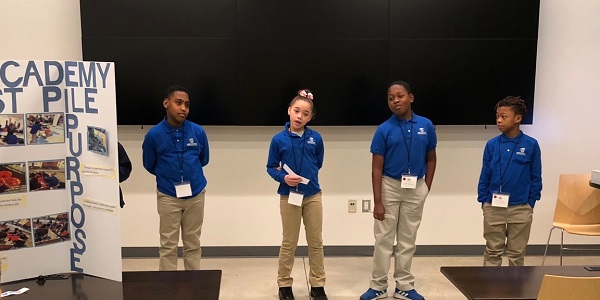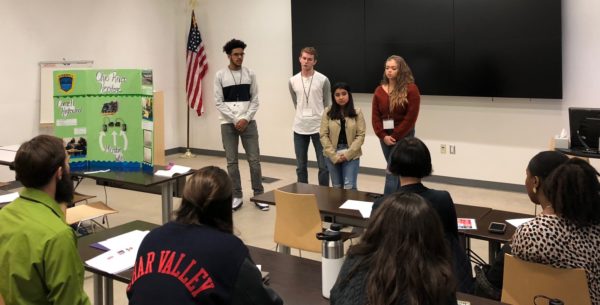
Seeds of Change conference showcases kid-inspired ideas on sustainability
Above: Kids from Urban Academy take the stage to present their project at the Seeds of Change conference. Photos by Stephanie Hacke
Each day for the past two months, fourth and fifth graders in the science enrichment class at Urban Academy of Greater Pittsburgh Charter School collected leftover carrots, peas and apples. They filled buckets with the scraps and carried them to the school garden to enrich the soil.
“When we create composts, we’re creating new soil, so we can make new plants and new plants will give us oxygen and we need oxygen to live,” explains 10-year-old Korey Johnson, who worked on the project.
“It helps you create a better Earth for everybody, so you don’t just have to throw things away,” chimes in classmate Xavier Bennett.
Their project was one of those presented at Chatham University’s Seeds of Change: Igniting Student Action for Sustainable Communities. The Urban Academy kids joined other K-12 student teams from 14 area schools for the annual conference, now in its third year.
Each group presented a sustainability project the kids worked on at their schools or with local nonprofits.
“Sustainability means so much more than just technologies,” says Kelly Henderson, Chatham’s Eden Hall K-12 education coordinator. “It’s about a way of thinking, a way of considering human health, considering happiness, considering equity and justice in every decision that we make.”
Seeds of Change challenges stidents to look at sustainability through the lens of the United Nation’s 17 Sustainable Development Goals. The goals include a world with no poverty, zero hunger, good health and well-being, quality education and gender equality.

The conference aims to give kids feedback on their projects, help them make connections with peers doing similar work and, most importantly, to inspire them to create more change in their communities. A few examples from the conference presentations:
- At Cornell High School, teachers secured grants from the Grable Foundation and Hillman Family Foundations to build a greenhouse outside the school’s cafeteria. But it was the kids who spearheaded much of the work, volunteering on construction, design and science committees. They came up with ideas like donating the food they grow to the local food bank and creating an outdoor classroom next to the greenhouse. Then, they made it happen.
- A food bank and learning garden were already established at Perry High School. But students now are working to unify the two programs through their “Straight Thuggin’ with the Earth” project. Under consideration: How can they make the programs better? How can they make them sustainable over time?
- At Nazareth Prep students Katie Donohue and Riyan Russell came up with the idea to add artwork to the streets of Rankin and Braddock through a neighborhood beautification project of sorts. They plan to hold a competition with unknown artists and display their work outdoors.
Three projects were each awarded $300 to help kids develop their ideas further: Perry High School for their Perry Learning Garden; City Charter High School for their Green Thumbs in Gray Spaces; and Operation Better Block for their Vacant Lot Maintenance.
Schools interested in having their students participate in next year’s challenge can begin with Eden Hall’s Introduction to Sustainability Lesson Plan.